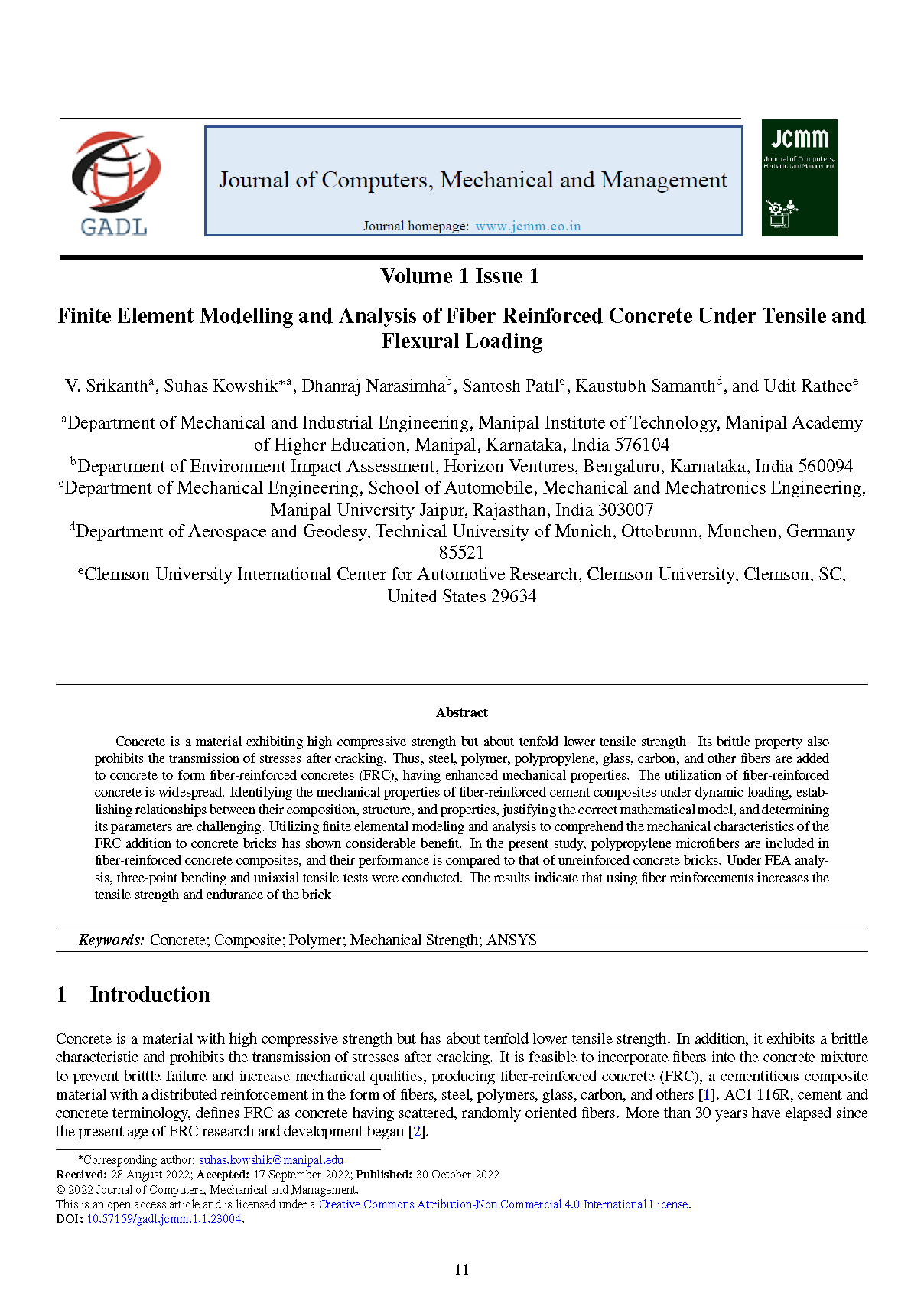Finite Element Modelling and Analysis of Fiber Reinforced Concrete under Tensile and Flexural Loading
DOI:
https://doi.org/10.57159/gadl.jcmm.1.1.22004Keywords:
Concrete, Composite, Polymer, Mechanical strength, ANSYSAbstract
Concrete is a material exhibiting high compressive strength but about tenfold lower tensile strength. Its brittle property also prohibits the transmission of stresses after cracking. Thus, steel, polymer, polypropylene, glass, carbon, and other fibers are added to concrete to form fiber-reinforced concretes (FRC) having enhanced mechanical properties. The utilization of fiber-reinforced concrete is widespread. Identifying the mechanical properties of fiber-reinforced cement composites under dynamic loading, establishing relationships between their composition, structure, and properties, justifying the correct mathematical model, and determining its parameters are challenging. Utilizing finite elemental modeling and analysis to comprehend the mechanical characteristics of the FRC addition to concrete bricks has shown considerable benefit. In the present study, polypropylene microfibers are included in fiber-reinforced concrete composites, and their performance is compared to that of unreinforced concrete bricks. Under FEA analysis, three-point bending and uniaxial tensile tests were conducted. The results indicate that using fiber reinforcements increases the tensile strength and endurance of the brick.
References
J. Blazy and R. Blazy, Polypropylene fiber reinforced concrete and its application in creating architectural forms of public spaces, “Case Studies in Construction Materials,” 14, p. e00549, 2021.
R. F. Zollo, Fiber-reinforced concrete: an overview after 30 years of development, “Cement and Concrete Composites,” 19 (2), pp. 107–122, 1997.
S. V. Klyuev, A. V. Klyuev, and N. I. Vatin, Fiber concrete for the construction industry, “Magazine of Civil Engineering,” 84 (8), pp. 41–47, 2018.
N. Belyakov, O. Smirnova, A. Alekseev, and H. Tan, Numerical simulation of the mechanical behavior of fiber-reinforced cement composites subjected dynamic loading, “Applied Sciences (Switzerland),” 11 (3), pp. 1–15, 2021.
T. C. Madhavi, L. S. Raju, and M. Deepak, Polypropylene Fiber Reinforced Concrete- A Review, “International Journal of Applied Engineering Research,” 4 (4), pp. 2250–2459, 2014.
S. Antonov, M. Gravit, E. Meshalkin, I. Dmitriev, and A. Shchukin, Study of the Compressive Strength of Concrete with Polypropylene Microfiber, in Lecture Notes in Civil Engineering, 180, 2022, pp. 543–552.
M. K. Yew, H. Bin Mahmud, B. C. Ang, and M. C. Yew, Influence of different types of polypropylene fibre on the mechanical properties of high-strength oil palm shell lightweight concrete, “Construction and Building Materials,” 90, pp. 36–43, 2015.
S. Deb, N. Mitra, S. B. Majumder, and S. Maitra, Improvement in tensile and flexural ductility with the addition of different types of polypropylene fibers in cementitious composites, “Construction and Building Materials,” 180, pp. 405–411, 2018.
A. Lakshmi, P. Pandit, Y. Bhagwat, and G. Nayak, A Review on Efficiency of Polypropylene Fiber-Reinforced Concrete, in Lecture Notes in Civil Engineering, 162, L. Nandagiri, M. C. Narasimhan, S. Marathe, and S. Dinesh, Eds. Springer, Singapore, 2022, pp. 799–812.
B. Li, Y. Chi, L. Xu, Y. Shi, and C. Li, Experimental investigation on the flexural behavior of steel-polypropylene hybrid fiber reinforced concrete, “Construction and Building Materials,” 191, pp. 80–94, 2018.
M. R. Latifi, Ö. Biricik, and A. Mardani Aghabaglou, Effect of the addition of polypropylene fiber on concrete properties, “Journal of Adhesion Science and Technology,” 36 (4), pp. 345–369, 2022.
S. M. Mahmoud, M. E. El-Zoughiby, A. A. Mahmoud, and M. A. Abd Elrahman, Nonlinear Finite Element Analysis of Polypropylene Lightweight RC Beams, “Engineering Research Journal,” 173 (0), pp. 1–15, 2022.
N. Hammad, A. M. ElNemr, and H. E. D. Hassan, Flexural performance of reinforced Alkali-activated concrete beams incorporating steel and structural Macro synthetic polypropylene fiber, “Construction and Building Materials,” 324, 2022.
P. Dhanabal, P. N. Reddy, and K. S. Sushmitha, Analytical and Experimental Study on Flexural Behavior of Beam-column Joint with Addition of Polypropylene Fibers, “Journal of Modern Materials,” 9 (1), pp. 26–35, 2022.
M. Hafezolghorani, F. Hejazi, R. Vaghei, M. S. Bin Jaafar, and K. Karimzade, Simplified Damage Plasticity Model for Concrete, “Structural Engineering International,” 27 (1), pp. 68–78, 2017.
J. M. Dulinska and I. J. Murzyn, Dynamic behaviour of a concrete building under a mainshock–aftershock seismic sequence with a concrete damage plasticity material model, “Geomatics, Natural Hazards and Risk,” 7 (sup1), pp. 25–34, 2016.
A. Furtado, H. Rodrigues, A. Arêde, H. Varum, M. Grubišić, and T. K. Šipoš, Prediction of the earthquake response of a three-storey infilled RC structure, “Engineering Structures,” 171, pp. 214–235, 2018.
S. Seok, G. Haikal, J. A. Ramirez, L. N. Lowes, and J. Lim, Finite element simulation of bond-zone behavior of pullout test of reinforcement embedded in concrete using concrete damage-plasticity model 2 (CDPM2), “Engineering Structures,” 221, p. 110984, 2020.
V. Popov, V. Morozov, Y. Pukharenko, and M. Plyusnin, Consideration of Variability of Concrete Characteristics in Calculation of Reinforced Concrete Structures, “Materials Science Forum,” 871, pp. 166–172, 2016.
H. Cheng, C. M. Paz, B. C. Pinheiro, and S. F. Estefen, Experimentally based parameters applied to concrete damage plasticity model for strain hardening cementitious composite in sandwich pipes, “Materials and Structures,” 53 (4), p. 78, 2020.
V. Afroughsabet, L. Biolzi, and T. Ozbakkaloglu, High-performance fiber-reinforced concrete: a review, “Journal of Materials Science,” 51 (14), pp. 6517–6551, 2016.
S. Hamoush, T. Abu-Lebdeh, and T. Cummins, Deflection behavior of concrete beams reinforced with PVA micro-fibers, “Construction and Building Materials,” 24 (11), pp. 2285–2293, 2010.
W. S. A. Nana et al., Behaviour of macro-synthetic fibers reinforced concrete: Experimental, numerical and design code investigations, “Structures,” 32, pp. 1271–1286, 2021.

Downloads
Published
How to Cite
Issue
Section
License
Copyright (c) 2022 Journal of Computers, Mechanical and Management

This work is licensed under a Creative Commons Attribution-NonCommercial 4.0 International License.
The Journal of Computers, Mechanical and Management applies the CC Attribution- Non-Commercial 4.0 International License to its published articles. While retaining copyright ownership of the content, the journal permits activities such as downloading, reusing, reprinting, modifying, distributing, and copying of the articles, as long as the original authors and source are appropriately cited. Proper attribution is ensured by citing the original publication.





